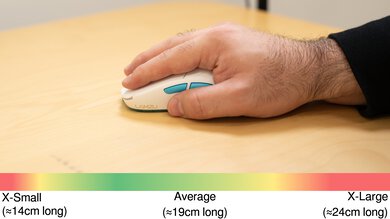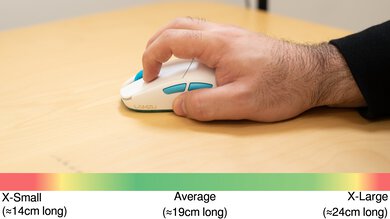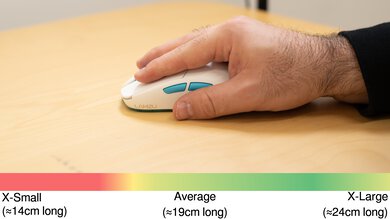The LAMZU Atlantis is a lightweight, wireless gaming mouse with a solid plastic shell and a symmetrical shape. Unlike many gaming models, this mouse is available in a range of vibrant colors, though it doesn't have any RGB lighting. It's among the first mice released from a smaller manufacturer using PixArt's flagship PAW 3395 sensor. It also features Huano Blue Pink Dot switches for its left- and right-click buttons and a TTC Gold scroll wheel encoder. The bottom plate of this mouse has an unusual sculptural design, which helps reduce the mouse's overall weight but leaves it more open to collecting dust and debris.
Our Verdict
Though not specifically designed for it, the LAMZU Atlantis is a satisfactory mouse for work use. The build quality is very good, and it has a comfortable symmetrical shape suitable for most hand sizes. Unfortunately, it doesn't support Bluetooth or multi-device pairing. Its scroll wheel also lacks tilt inputs and doesn't have a free-scrolling mode.
- Impressive build quality.
- Comfortable symmetrical shape.
- Scroll wheel lacks left and right tilts and doesn't unlock for free-scrolling.
- No support for Bluetooth or multi-device pairing.
The LAMZU Atlantis is an excellent FPS gaming mouse. It's remarkably lightweight with a comfortable symmetrical shape well-suited for most hand sizes. It has very low click latency and accurate and consistent sensor performance providing a snappy and responsive in-game experience. Overall its build quality is very good, and it has outstanding mouse feet that glide very smoothly on mousepads and desks. That said, there's minor left and right wobbling in the left- and right-click buttons and some creaking and flexibility in the body. Otherwise, the build quality is very good, and these minor issues don't affect performance during gameplay.
- Impressive build quality.
- Comfortable symmetrical shape.
- Remarkably lightweight.
- Excellent click latency.
- Impressive overall sensor performance.
- Somewhat higher 'delay to first movement' test result than most mice using the same sensor.
Though not designed specifically for this usage, the LAMZU Atlantis is good for MMO gaming. The sensor performance and click latency are excellent, producing a smooth and responsive in-game experience. This mouse doesn't have nearly as many side buttons as most dedicated MMO gaming mice. Also, while its build quality is very good overall, there's some minor flexibility in the body and minor wobbling in the left- and right-click buttons. However, this doesn't present any issues during regular use.
- Impressive build quality.
- Comfortable symmetrical shape.
- Excellent click latency.
- Somewhat higher 'delay to first movement' test result than most mice using the same sensor.
- Not nearly as many side buttons as a dedicated MMO model.
The LAMZU Atlantis has excellent raw performance. Its sensor is very accurate and consistent, and it has a maximum polling rate of 1000Hz, which produces smooth cursor movements and is the current standard for gaming mice. Its click latency is also excellent, so you won't notice a delay between your clicks and when in-game actions appear on-screen. However, while the result of the 'delay to first movement' test for this mouse is good, it's somewhat higher than most mice using the same sensor. You won't notice this additional delay during gameplay, but it may have a minor impact on gaming performance. For more details, see the Sensor Latency test below.
- Excellent click latency.
- Somewhat higher 'delay to first movement' test result than most mice using the same sensor.
Changelog
- Updated Aug 28, 2025: We've converted this review to Test Bench 1.5.1. This update removes less relevant or redundant elements, including several videos. We've also adjusted our Sensor Latency testing, resulting in minor score changes. See our full 1.5.1 changelog for details.
-
Updated Mar 25, 2025:
We've added a link to the WLmouse Strider in the Sensor Specifications section.
- Updated Apr 10, 2024: We've changed one of the test results in the Additional Buttons section of this review. Previously, we indicated the Number Of Programmable Inputs result was 6, but we've revised this total to 5, as the left-click function must always be assigned to a button.
- Updated Feb 20, 2024: We've updated the 3D scan in the Shape section of this review because the previous scan was off-centered.
Check Price
Differences Between Sizes And Variants
The LAMZU Atlantis is available in several colorways, including Miami Blue, Matcha Green, Pink, Polar White, and Black. The unit we purchased and tested is the Polar White version. You can see the label for our unit here. LAMZU has also indicated they will be releasing a somewhat smaller and slightly lighter variant of this mouse called the LAMZU Atlantis Mini.
Popular Mouse Comparisons
The LAMZU Atlantis is a lightweight wireless gaming mouse and is among the first mice released that uses PixArt's flagship sensor, the PAW 3395. This mouse is available in various colors and has an unusual open framework baseplate. This baseplate sets this mouse apart visually from many similar gaming mice, and it contributes to reducing the overall weight of the mouse, making it easier to move quickly and accurately for fast-paced games. It's a medium to large-sized mouse best suited for a claw or fingertip grip and bears close similarities to the shape of the Endgame Gear XM1r.
For more recommendations, see our picks for the best gaming mouse, the best wireless gaming mouse, and the best lightweight mouse.
The LAMZU Atlantis and the LAMZU MAYA are both lightweight, wireless gaming mice. The Atlantis is bigger with a more rearward hump and more aggressive curves. It's best suited for a claw grip. The MAYA is lighter and smaller and has a lower central hump. Its shape is more versatile and accommodating for palm, claw, or fingertip grip types.
The LAMZU Atlantis and the LAMZU THORN are lightweight wireless gaming mice. The Atlantis has a lower profile and a symmetrical shape and is available in more colors than the THORN. The THORN has a right-handed design and has slightly better sensor performance than the Atlantis. The THORN also uses optical switches for its left- and right-clicks instead of the mechanical ones on the Atlantis.
The Logitech G PRO X SUPERLIGHT and the LAMZU Atlantis are both lightweight wireless gaming mice with symmetrical shapes. The Logitech has a somewhat better gaming performance and a more subdued visual appearance. It also feels sturdier and is better suited to a broader range of hand sizes and grip types. On the other hand, the LAMZU is a bit lighter. It's also available in a wider range of colors and has an unusual sculptural baseplate design.
The Pulsar X2 and the LAMZU Atlantis are lightweight wireless gaming mice with similar shapes. The Pulsar is slightly smaller and delivers somewhat better sensor performance. On the other hand, the LAMZU is a bit bigger, and its back end is a little wider. Each mouse is available in various colors, but the LAMZU has more colorway options.
Test Results

This mouse is available in a range of colors. The unit we purchased and tested has a matte white plastic body with teal-colored accents on the scroll wheel and side buttons. The baseplate is also made of teal-colored plastic and has a sculptural, open design that allows you to see inside the mouse. There's a small LED light behind the left- and right-click buttons to indicate the battery level and another LED indicator that shines faintly through the baseplate to indicate your CPI setting. While these lights' colors change, they serve as indicator lights rather than programmable RGB lighting. If you're interested in a similar wireless gaming mouse with a more subdued look and a more conventional solid baseplate design, check out the Ninjutso Sora or the Endgame Gear XM2we.
The baseplate of this mouse isn't a solid piece of plastic but a frame made of transparent plastic with open spaces revealing the interior of the mouse. You can see a photo of what the bottom of the mouse looks like here. Because the 3D scanning tool has a limited ability to capture open voids and has difficulty scanning transparent materials, we've covered the bottom of the mouse with tape during the scanning process to provide a more accurate and readable 3D scan.
This mouse has a very good build quality and has a solid plastic top shell covered with a matte surface that feels good in your hand. There's no wobbling or rattling sounds if you shake the mouse, but there's a bit of side-to-side travel in the left- and right-click buttons. There's also some flexibility in the body and particularly the bottom of the mouse, which isn't a solid piece of plastic as it is on most mice. Additionally, if you squeeze with enough force, the left side emits a faint creaking sound. Overall, these are minor issues that don't present problems during everyday gaming use.
The LAMZU Atlantis has a centered hump towards the back and a wide rear end designed to fill out your palm. Its shape is especially well-suited to support a claw grip for most hand sizes. That said, the overall size of the mouse and its width towards the back can make it unwieldy to hold if you have very small hands. The sides of the mouse are also angled noticeably inward, which can make it feel quite narrow if you have particularly large hands. If you're looking for a mouse with a smaller hump and a narrower shape, check out the Pulsar X2V2, or if you're looking for a mouse with the same shape but smaller, check out the LAMZU Atlantis Mini 4K.
LAMZU advertises this mouse has a battery life of up to 70 hours. It's the standard battery life for an upper mid-range gaming mouse but is somewhat shorter than the battery life on some premium gaming mice, like the Razer Viper V2 Pro. This mouse also has a small LED light just below the left- and right-click buttons displaying the battery status. If you're interested in a similar lightweight wireless gaming mouse with a longer advertised battery life that supports a Bluetooth connection, check out the HyperX Pulsefire Haste 2 Wireless.
This mouse has a lightweight and flexible paracord-like charging cable that glides well across desks and mousepads. However, it does retain some permanent kinking from its packaging.
This mouse has exceptional feet that move very smoothly on mousepads or directly on desks without resistance or drag. They make very slight scratching sounds, but this doesn't affect the gliding experience. There are replacement feet available from the company's website, including glass and sapphire feet options.
This mouse's left- and right-click buttons use Huano Blue Shell Pink Dot mechanical switches, which feel very crisp.
Some owners of this mouse have identified online that there's a small tactile bump near the beginning of the button's pre-travel movement. You can see this bump visible in the Main Button Actuation Graph. Note that this bump is fairly hard to notice for most people when it isn't pointed out and doesn't impact the button's functionality. It may irritate you if you're particularly sensitive to irregularities in click feeling or if you'd prefer smoother, more uninterrupted pre-travel.
You can program all of the buttons on this mouse, including the CPI button on the underside. However, you can't reprogram the scroll up or down inputs, and the left-click function must always be assigned to a button.
This mouse has excellent click latency, providing a snappy and instantaneous-feeling experience for gaming in any genre.
The LAMZU Atlantis has impressive sensor latency performance overall. During our initial testing, we found the sensor enters a power-saving idle mode within five seconds, which is much quicker than most gaming mice. It's intended to optimize the battery life, but it also means there is added input lag when you begin moving your mouse again after the idle mode engages. There's a firmware update available on LAMZU's website that you can download that extends the period before the sensor goes into idle mode. We had difficulty updating the firmware but could solve the problem by ensuring the LAMZU configuration software was closed while trying to update.
Unrelated to the timing of the idle sensor mode, this mouse also has a somewhat higher result for the 'delay to start of movement' test than other mice we've tested with the same sensor. The result is still good, and you won't notice this slight delay during gameplay. However, it may still affect your performance in fast-paced and competitive games.
The available polling rate options are 125Hz, 250Hz, 500Hz, and 1000Hz.
If you're interested in a mouse with a similar shape and support for a maximum wireless polling rate of up to 8000Hz, check out the WLmouse Strider.
The customization software is easy to use and simple. It has a straightforward layout and doesn't feel as bloated as the software options from larger mouse manufacturers. This software allows you to adjust a range of settings, including CPI, button programming, lift-off distance, debounce settings, and custom profiles.












